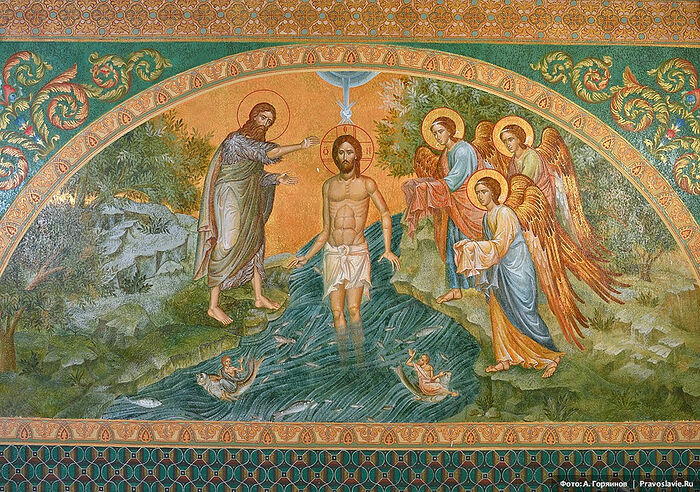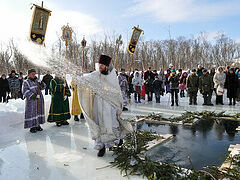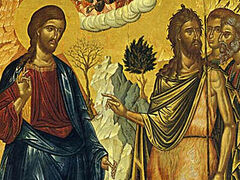Then cometh Jesus from Galilee to Jordan
unto John, to be baptized of him (Mt. 3:13).
The Baptism of our Lord, God, and Savior Jesus Christ is known as the feast of the Theophany of the Lord in the Orthodox Tradition.
Turning our attention to Holy Scripture, where the events connected with the Baptism of Jesus Christ are described, we can see how the Lord, obeying the laws of human nature, was plainly and visibly baptized in the Jordan River. This event was accompanied by wondrous phenomena: the water in the Jordan stopped, the heavens opened up, and the voice of the Heavenly Father was heard and the Holy Spirit was seen as a dove.
Thus, the manifestation of the Most Holy Trinity during the Baptism of the Lord is the reason for this name of the feast—the Theophany of the Lord.
The Baptism of the Lord is among the Twelve Great Feasts. This great celebration is celebrated in the Orthodox Church with majesty equal to that of the Nativity of Christ. Both feasts, connected by Christmastide, make up one majestic and soul-saving celebration.
The central and most well-known liturgical hymns of this feast are, of course, the troparion and kontakion:
Troparion
When Thou, O Lord, wast baptized in the Jordan, the worship of the Trinity was made manifest; for the voice of the Father didst bear witness unto Thee, calling Thee His beloved Son. And the Spirit, in the form of a dove, didst confirm the truthfulness of His word. O Christ our God Who hast revealed Thyself and hast enlightened the world, glory to Thee!
Kontakion
Today Thou hast shown forth to the world, O Lord, and the light of Thy countenance hath been marked upon us. Knowing Thee, we sing Thy praises. Thou hast come and revealed Thyself, O unapproachable Light.
The River Jordan
The troparion of the Baptism of the Lord begins by mentioning the Jordan River, where occurred this great event, accomplished by the Savior as an example, that all who believe in Him might be baptized with water and the Spirit and have life eternal: “When Thou, O Lord, wast baptized in the Jordan (or “At Thy Baptism in the Jordan”).
The Gospel of St. John the Theologian (Jn. 1:28) indicates the place where the Baptism of the Lord occurred—Bethabara (Greek: Βηθαβαρᾶ, Βηθααβαρά, Βηθαβαρά; meaning “house/place of crossing” in Hebrew). It’s believed there was a crossing over the Jordan there during the earthly life of Jesus Christ, used by pilgrims from Galilee going to Jerusalem through the Jordan, bypassing Samaria. The exact location is unknown to us.
The worship of the Trinity
Holy Scripture, describing the Baptism of the Savior, clearly shows us the most important event for the entire Christian world—the manifestation of the Holy Trinity. The New Testament thrice reveals to us the mystery of the Holy Trinity: at Theophany, the Transfiguration, and the descent of the Holy Spirit.
The Omnipotent God, the Creator of Heaven and earth, “the Wonderful Counsellor, the ruler of the world,” for the first time reveals Himself to mankind in Three Persons: God the Father—by His voice, God the Son—by His Baptism in the Jordan, and the Holy Spirit—by His descent in the form of a dove.
This is why the troparion of the feast says that on this day “the worship of the Trinity was made manifest.” The true worship of God was revealed to man; the hitherto unknown mystery of the Godhead as Trinity, the mystery of God, One in Three Persons, was revealed.
The Spirit in the form of a dove
The great mystery of the Savior’s ministry is revealed in His Baptism. This is indicated by the words of the Heavenly Father: This is My beloved Son, in Whom I am well pleased (Mt. 3:17). Two people heard these words: the Lord Himself and St. John the Baptist. The words applied only to Jesus, but the Forerunner was finally convinced by this testimony that this is truly the Son of God, the Messiah, come to save the world.
Based on the text of the troparion, the descent of the Holy Spirit can be said to be a kind of seal that completes the action, closing the book on and confirming the truthfulness of this great mystery of the Theophany.
The Holy Spirit confirmed the words of the Heavenly Father, Who said: This is My beloved Son, in Whom I am well pleased.
The appearance of the Lord
Reading the kontakion of the Baptism of the Lord, we note one feature: The troparion is addressed to God the Son, whereas the kontakion isn’t addressed to any particular person of the Holy Trinity, but rather to God—the Father, Son, and Holy Spirit.
Divine grace, which many Holy Fathers associate with light, places the seal of the Holy Spirit upon Christians during their Baptism, thereby separating them from worldly people, numbering them as part of the Church of Christ.
The verb used in Church Slavonic for the light being “marked” upon us can also mean “to consecrate.” Thus, we could interpret the troparion like this: By His unspeakable mercy and love, God gives His Only-Begotten Son over to death, that whosoever believeth in Him should not perish, but have everlasting life (Jn. 3:16). Having come to the Jordan, Christ is baptized by John, thereby showing us the path, illumined with the light of His Divine grace, and pointing us to Baptism by water, that having been baptized, we might be sanctified and partake of this great mercy—God’s grace.
Going deeper into the interpretation of the kontakion, we can see that the author enclosed the most important thing—the meaning of the feast of the Theophany of the Lord—in but a few strokes: the salvation of all mankind through the manifestation of the unapproachable light; that all believers, seeing this light, might go out to meet Him.
“Unapproachable” can also mean “unchangeable, indestructible.”
Accordingly, God, Who revealed Himself to us in Trinity during the Baptism of God the Son, is that unchangeable light upon which people must place their trust, understanding that this light is our reliable and only guide to eternal blessedness.




